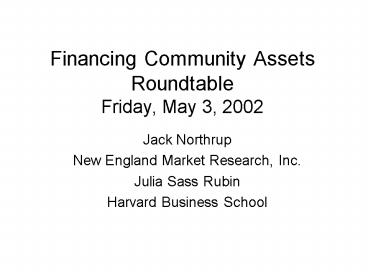Financing Community Assets Roundtable Friday, May 3, 2002 - PowerPoint PPT Presentation
1 / 12
Title:
Financing Community Assets Roundtable Friday, May 3, 2002
Description:
Julia Sass Rubin. Harvard Business School. Mapping the nonprofit capital markets ... utilize targeted state bond issues to subsidize loan repayments ... – PowerPoint PPT presentation
Number of Views:37
Avg rating:3.0/5.0
Title: Financing Community Assets Roundtable Friday, May 3, 2002
1
Financing Community Assets Roundtable Friday,
May 3, 2002
- Jack Northrup
- New England Market Research, Inc.
- Julia Sass Rubin
- Harvard Business School
2
Mapping the nonprofit capital markets
- Nonprofit Capital A Review of Problems and
Strategies - By Bill Ryan
- Fannie Mae and Rockefeller Foundations
- Sources of Funding for Community Wealth
Enterprises - By Ed Barker
- Community Wealth Ventures
3
Mapping the nonprofit capital markets
- Going Mainstream NPOs Accessing the Capital
Markets - By Gregory M. Stanton, Jed Emerson, and Marcus
Weiss - The first condition is that any meaningful
financial technical assistance between Wall
Street professionals and NPO senior management
can exist only if the NPO has bankable,
financeable assets. These assets must generate
predictable and measurable cash flows sufficient
to service some form of debt or meet investors
expectations.
4
Mapping the nonprofit capital markets
- The Venture Fund Initiative An Assessment of
Current Opportunities for Social Purpose Business
Development and Recommendations for Advancing the
Field - Initiated by Jed Emerson, Roberts Enterprise
Foundation, 1998 - In the specific area of nonprofit enterprise,
many ventures are significantly
under-capitalized. They are often funded with
one-time grants, self-financed by the nonprofit
or supported with high-cost debt. To have even a
modest hope of success, the nonprofit must be
able to access additional financial support to
adequately cover costs related to growing the
venture and supporting what are often significant
cash flow requirements. - While highly fragmented, the nonprofit capital
market consists of a continuum of capital
instruments. These instruments include grants,
recoverable grants (which function as no interest
loans), program-related investments (below
market-rate loans), various forms of commercial
debt (these would include lines of credit and
fixed-rate loans) and equity equivalents.
5
QUESTIONS DRIVING THE STUDY
- What are the capital needs of social enterprises?
- Do models exist for addressing those needs?
- If not, can such models be borrowed or developed?
6
STUDY METHODOLOGY
- Phase I
- open ended phone interviews with
- social entrepreneurs
- annual budgets of 123 thousand to 7 million
- 25 to 98 self-sustaining
- advisors/funders to the field
- interviews designed to understand
- capital needs of social enterprises
- models that exist (or can be borrowed/ adapted)
to address those needs
7
What are the capital needs of social enterprises?
- Patient capital to start new ventures and grow
existing ones - Access to straight debt less problematic than to
equity, - variable access to unsecured debt (revolving
lines of credit) - minimal cash flow and ability to repay even
below-market rate loans - no collateral available (except mortgages)
- traditional capital sources may have perception
of soft business approach
8
What are the capital needs of social enterprises?
- Social enterprises reluctant to take on debt for
growth or new venture development - 55 currently have non real-estate debt
- primarily revolving lines of credit from banks
CD sources - rates of 3 to 1 point over prime
- Several debt funds closed down due to lack of
demand - Urban Enterprise Fund, Chicago
- Keystone Ventures, San Francisco
- Existing ventures primarily funded through grants
- Need patient capital with very flexible repayment
requirements - recoverable grants
- zero interest loans with subsidized repayments
9
Existing sources of patient capital for social
enterprises
- Foundation PRIs and equity equivalents
- low interest debt
- often seen as forgivable by recipients
- Philanthropic and government grants
- increasingly difficult to obtain
- most not willing/able to fund new business
creation or working capital needs - Internally generated cash flow
- limited
- leads to very slow growth
- inaccessible for new business creation
10
Roberts Enterprise Fund
- Focus on workforce development/transitioning
populations - True venture philanthropy model utilizing
- intensive technical assistance
- recoverable grants
- none repaid to date
- cash guarantees
- low-interest loans
- revolving credit line
- Businesses competitive in marketplace but low
margins because of need for high-end service
provision to employees
11
SEEDCOs Nonprofit Venture Network
- Assists nonprofits starting social-purpose
businesses began 2001 - currently in NY only
- plans to expand to Tampa and Boston
- Three phase program
- Phase I assessment and capacity building
- 3 free workshops business planning, financing,
risk mitigation - apply for up to 15K in grants and find a match
- Phase II intensive planning assistance
- work closely with nonprofits on business planning
over one year period - Phase III venture portfolio
- provide introduction to different sources of
capital, including SEEDCO loan fund - looking at ways to provide more patient capital
12
LISCs Childcare Facilities Initiative
- Work at national and state levels
- develop sources of public and private capital to
fund childcare facilities - financing primarily unsecured projects
- Public sector
- utilize targeted state bond issues to subsidize
loan repayments - subsidy includes interest plus 80 to 100 of
loan amount - demonstration project in Illinois
- programs in Connecticut and Rhode Island
- Utilize recoverable grants from LISC
- recover close to 90
- Raise operating funds and grants from states,
foundations and CDFI Fund






























![Decentralised Finance [DeFi] Growth in 2021 PowerPoint PPT Presentation](https://s3.amazonaws.com/images.powershow.com/9620252.th0.jpg?_=202106250611)
